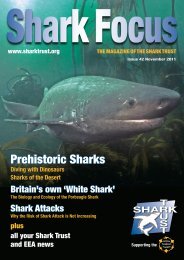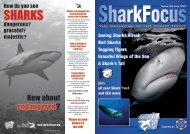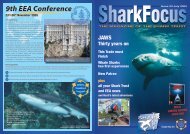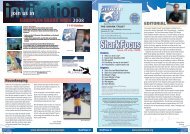WORLD SHARKNEWSNews since last <strong>Focus</strong>SHARK TRUST PROJECTSNEWSGoodbye Rachel.JUNEDeath of Manta Ray sheds new light on speciesThe Okinawa Churaumi Aquarium in Japan saw the first birth of a Manta Ray in captivity. Unfortunately,the baby ray died five days later, in part from injuries inflicted by its father.Recent parthenogenesis findings in female sharks in captivityThe mysterious appearance in 2001 of an infant female bonnethead shark at Omaha’s Henry Doorly Zooin a tank that held only two adult female sharks was the result of parthenogenesis (virgin birth).Sea Shepherd Galapagos sting results in seizure of over 18,000 shark finsSea Shepherd Conservation Society seized a total of 18,673 shark fins and arrested four suspects. InEcuador, exportation and commercialisation of shark fins is against the law.Taiwan to ban Whale <strong>Shark</strong> tradeProducts derived from Whale <strong>Shark</strong>s are now banned from sale in Taiwan. Fishermen are obliged toreturn caught Whale <strong>Shark</strong>s to the ocean, whether the fish is dead or alive.JULYFirst quality footage of free-swimming PorbeaglesRichard Peirce, Chairman of the <strong>Shark</strong> Trust, used two polecams to obtain the first ever quality underwaterfree-swimming footage of Porbeagle <strong>Shark</strong>s. The expedition took place off the North Cornish Coast.Ban lifted on sale of shark fins in EcuadorEcuador’s president overturned a ban on the sale of shark fins, but stipulated they can only be sold if thesharks are caught accidentally. Rafael Correa said legalization of the sale of shark fins would generate incomefor fishermen but added that shark fishing would remain illegal.First successful mating of Angel <strong>Shark</strong>s at Deep Sea WorldDeep Sea World, Fife has just confirmed that its female Angel <strong>Shark</strong> – on loan from Underwater World,Hastings - is pregnant. This is a first for this rare species in the captive environment.EGGCASE HUNTING Down UnderJo Stead is a PhD student studying shark biology and ecology in Moreton Bay, Nr Brisbane, Australia. In<strong>Shark</strong> <strong>Focus</strong> 27 we told you about the Great Eggcase Hunt taking off around the world. Jo contacted usto tell us about some lucky eggcase finds in Australia.The University of Queensland has a research stationon North Stradbroke Island and on two occasionsBrownbanded Bambooshark egg cases have beenfound along the shore and taken to the researchstation.The first was discovered washed up on the rocksnear the research station just before Christmas 2003and was placed in the station’s aquarium system inthe hope it had survived.Lucky the Brownbanded Bambooshark in her tank.Finally on Friday March 3rd 2004 the egg hatched anda female pup emerged. Weighing 23.9g and 19.3 cmlong the station staff named her “Lucky”.Recently two other stranded egg cases werediscovered by local 12-year-olds Hunter Murray andJai Burns.After 3 months the first egg hatched and the pupwas immediately dubbed “Lucky 2”, the secondpup hatched a couple of days later and was named“Speedy”. Once the sharks have grown a little biggerthey will be released back into the wild.THE DEEPEGGCASE HUNTSMany thanks, again, go to Claire Richards of TheDeep aquarium, Hull. After running seven GreatEggcase Hunts on the northeast coast last yearand finding just one catshark eggcase. Claireorganized a further five eggcase hunts, this year,to see if she could find more. Over 70 peopleattended these hunts and… found no eggcases!This is a very interesting and important resultas although many skate and ray species havebeen over-exploited, there are still many catsharkslaying eggs in the North Sea which poses thequestion – where are their eggcases going?Check out www.eggcase.org for more eggcaseinformation.Hello Nick!New Staff Member!It is with sadness that the <strong>Shark</strong> Trust bids a fondfarewell to Rachel Turner who has moved on from the<strong>Shark</strong> Trust to begin a PhD at Newcastle University,we wish you every success. We welcome Nick Steelas her replacement and will now be on the other endof enquiries@sharktrust.org if you would like tospeak to him.Photo CompetitionThere were over 400 entries to the <strong>Shark</strong>s in <strong>Focus</strong>photography competition, some stunning, someemotive, some funny and all of them demonstratingthe power that sharks have to capture the imagination.The winning photo was announced at the BirminghamDive Show and it, with a selection of the othercommended photos, can be seen on page 12 and 13.Sightings DatabaseThe <strong>Shark</strong> Trust has developed an online database tohouse records of shark, skate and ray sightings andcatches. The database allows users to upload imagesand sighting information from any shark, skate or rayinteraction from anywhere in the world. This is thencatalogued and displayed on the <strong>Shark</strong> Trust website– www.sharktrust.org/sd. Log on to submit yourimages and tell the rest of the world what you saw!AUGUSTPorbeagle <strong>Shark</strong>s at risk after fisherman lands 60 in single dayConservationists are investigating reports of a vast catch of more than 60 rare sharks by a long-linefisherman operating from a port in North Devon.<strong>Shark</strong>s have genes for fingers and toesThe basic process for developing fingers and toes in land animals may have existed for more than500 million years in shark genes. The discovery pushes back the date of the evolutionary “fin to limb”advance by some 135 million years.Third-ever White <strong>Shark</strong> on display at aquariumFor the third time since 2004, the Monterey Bay Aquarium has placed a young white shark on publicexhibit. The aquarium hopes to keep him on exhibit for several months.SEPTEMBER<strong>Shark</strong>s as far as the eye can seeOver 400 Basking <strong>Shark</strong>s were seen feeding off plankton fronts off Land’s End. It is possible that oursummer of bad weather may have prevented the plankton fronts from forming and the return of summerhas allowed for these fronts to formPacific Angel <strong>Shark</strong> born in S.F. aquarium; believed first in captivitySan Francisco’s Aquarium of the Bay is claiming the first-ever birth of a captive Pacific Angel <strong>Shark</strong>.OCTOBERPygmy swellshark found in Sarawak watersMarine scientists from the Fisheries Research Institute (FRI) here have discovered a new species ofswellshark in the waters off Sarawak.SHARK TRUST OutreachBig Draw at the Dive ShowThe <strong>Shark</strong> Trust was, once again, present at oneof the UK’s largest dive expositions spreadingawareness about sharks and engaging members ofthe diving community in shark conservation.The Trust had a large presence at the showcomprising the awareness and sales stand, a BigDraw event ‘The 3D Undersea Megacreativity’ anda gallery of the winning images in the ‘<strong>Shark</strong>s in<strong>Focus</strong>’ photography competition.Manned admirably by a team of enthusiastic anddedicated staff members and volunteers the <strong>Shark</strong>Trust gained nearly 30 new members, got over1500 people to sign the ‘Every Fin Counts’ antisharkfinning petition and garnered nearly 1000entries into our prize draw! See page 14 and 15 formore information on European <strong>Shark</strong> Week.As part of the <strong>Shark</strong> Trust’s entry for the BigDraw campaign, visitors to the Dive Show wereencouraged to draw their favourite sharks andother underwater animals for the 3-D UnderseaMegacreativity and over two days created a minidive site in the middle of the Dive Show.The overall winner of the <strong>Shark</strong>s in <strong>Focus</strong>competition was announced as Andrew Bellamyand a gallery of some of the winning and highlycommended images was on display. The winningimage and some of the other commended imagescan be seen on pages 12 and 13!The <strong>Shark</strong> Trust wishes to thank all of thehardworking volunteers and staff members whohelped us out over the weekend – Thanks verymuch! Pictures and a report can be seen on the<strong>Shark</strong> Trust website. Many thanks also go toNorthern Diver who generously donated a fantasticcamera with underwater housing as our show prize.<strong>Shark</strong> Trust at the Dive Show.6 www.sharktrust.org <strong>Shark</strong> <strong>Focus</strong> 30 <strong>Shark</strong> <strong>Focus</strong> 30 Go to www.sharktrust.org >>> galleries to see Dive Show pictures 7
MEMBER’S pagesArtisanal <strong>Shark</strong> Fishing in Tofu Beach, MozambiqueCarpet <strong>Shark</strong> Research Down UnderI am a PhD student studying their biologyand ecology. Based at the Universityof Queensland, Australia and I amstudying three species of carpet shark:the Brownbanded Bambooshark, andthe Spotted and Dwarf Banded (Ornate)Wobbegongs. All three of these speciesoccur locally, so the majority of myfieldwork is conducted in and aroundMoreton Bay, just off Brisbane.Wobbegongs are a benthic shark found aroundAustralia and South East Asia. There are currentlyseven described species of wobbegong and they allhave attractive camouflage spot patterns on theirback and fleshy lobes, known as ‘barbels’, aroundtheir mouth. Apparently, they get their name fromthese barbels as wobbegong means ‘bearded fish’ ina southern aboriginal dialect.Although wobbegong sharks are not activelytargeted by fisheries in Queensland they arefrequently caught as bycatch. There is a targetedfishery for them in New South Wales and this hasexperienced significant declines in catch rates overthe past decade. Spotted and Ornate Wobbegongshave both been classed by the World ConservationUnion (IUCN) as ‘Vulnerable’ in NSW and ‘NearThreatened’ throughout the rest of their range.The Brownbanded Bambooshark is a speciesof long tailed carpet shark. It has a large rangethat extends from the northern coast of Australiathrough South East Asia to the east coast of India.Throughout this range it is collected for aquaria andin Southeast Asia it is actively targeted by artisanalfisheries. Although not targeted in Australia it isfrequently taken as bycatch. Globally, BrownbandedBamboosharks are classed by the IUCN as ‘NearThreatened’Snorkelling with a wobbegongAll three species are important species forboth fisheries and the aquaria trade. Yet,despite their commercial importance, verylittle is actually known about their biology.The successful management andconservation of any species can only beimplemented once a sound knowledge ofits biology has been attained. Thereforethe aim of this research is to determine asmuch as possible about their biology andecology in the hope that this informationwill be applied to their sustainablemanagement and conservation.The main emphasis of my research ison the Brownbanded Bamboosharks, but Iam working in collaboration with Dr CharlieHuveneers, who recently completed astudy on wobbegong biology in NSW, withthe aim of filling any gaps of informationon wobbegong biology. Wobbegongsand bamboo sharks are frequentlyfound/caught together and it is interestingecologically to investigate how these twoapparently similar sharks co-exist.One of the study sites is the rock wall at Amity,North Stradbroke Island. This has been the siteof a tag and release study to determine spottedwobbegong growth rates. Each wobbegong is caughtby hand net while free diving and is subsequentlymeasured, weighed, tagged and then released. Thewobbegongs seem to remain in this area and ithas been possible to recapture many of them anddetermine their growth rates in the wild.A similar tag and release study of bamboo sharksis being conducted throughout Moreton Bay with thehelp of local fishers. As well as trying to determinegrowth rates other aspects of their biology is beinginvestigated including their diet, reproductive andfeeding behaviour, and their habitat use by a taggingand tracking study.The habitat an animal uses in a normal24hr cycle is often referred to as its homerange. Information regarding an animal’shome range is particularly important forthe creation of effective protection zones.To date two successful tracks havebeen conducted and provisional resultsindicate that bamboo sharks have smallhome ranges and feed on the incominghigh tide in the mangroves.Joanna SteadJo releasing a taggedcarpetshark.Fundraising for the <strong>Shark</strong> TrustAs we are going to press, long time sharkenthusiast Kosh Kelly intends to cycle fromWhitehaven, North Yorkshire to SunderlandTyne and Wear – a journey of around 100miles – in just 24 hours!Using the C2C cycle route Kosh will betaking on the challenge on the 9th Novemberand donating all of his sponsorship moneyto the <strong>Shark</strong> Trust.Asked about this epic test Kosh notes that“I’ve been training for this ride since March2007, but I don’t think any physical trainingwill help with the mental side of riding fortwenty four hours”.Our thoughts are with you Kosh and wewish you every success. If anyone wouldlike to sponsor Kosh in his challenge pleaseemail enquiries@sharktrust.org and wewill gladly pass on your details.Beside the Indian Ocean Mozambique is host toapproximately 114 species of elasmobranch fishes.I have witnessed the extirpation of four of thesespecies due to the small fleet of artisan fishermenbased nearby. The artisanal sector is widespreadalong the length of the Mozambique coastline, withan estimated 15,000 boats operating throughout.These boats provide employment for around 58,000people, but the impact on the local shark populationis devastating.There are four active shark fishers who, instead ofutilizing boats, actually swim out from the headlandsto set longlines with approximately 20 hooks to beretrieved the following day.Several elasmobranch species are caught fromTofo Beach including mantas, devil rays, whiprays,stingrays, white spotted eagle rays and zebrasharks which are targeted mainly by spear-fishers.Line fishers have been seen to land guitarfish,hammerheads, tiger and various other carcharhinidsharks during normal fishing activities, indeed severallarge ray and shark species are caught each week.Local populations of white-spotted guitarfish andbow-mouth guitarfish have been reduced to very lowlevels.I’m at Tofo Beach, Inhambane province, Mozambique,to my left is a female blacktip shark, pregnant with two pups,beside her is a juvenile tiger shark under a metre in length.In normal circumstances this would be a joyous occasion with two such beautifulanimals in close proximity. However, these sharks are dead, the fishermen who havecaught them are removing their fins to sell and the two pups are cast aside.Although shark meat is utilized, sharks are oftentargeted for their fins which are sold directly to buyersin the Mozambique capital of Maputo. There is onemain fin buyer in Inhambane. According to one spearfisher,sharks and guitarfish are target species dueto their relative large size, fins are apparently beingon-sold to Chinese buyers in Maputo.In Mozambique, catch restrictions are in place, two“tubaroes” per fisher per day is allowed with theexception of “Tubarao branco”, the white shark,the only protected shark in Mozambique (1). Thelegislation seems encouraging on paperwork, but ashark is a shark to the local fisherman on his boat,exact species identification or conservation status isirrelevant.Representatives from Eyes On The Horizon (EOTH)and local government officials joined forces toinvestigate the illegal fisheries operating from TofoBeach. This operation confiscated eight illegal longlinesrigged for sharks. Given that the large hooks,swivels and steel traces are difficult to source inMozambique, it appears likely that fishermen arebeing supplied from non-local sources.Drew Corma(1) “Colectanea de Legislacao do Ambiente” (2ndedition) Lei de Pescas:Anexo 2:page, 371.8 Send in your stories to enquiries@ www.sharktrust.org <strong>Shark</strong> <strong>Focus</strong> 30 <strong>Shark</strong> <strong>Focus</strong> 30 Send in your stories to enquiries@ www.sharktrust.org 9
















